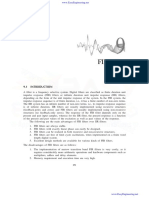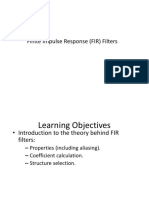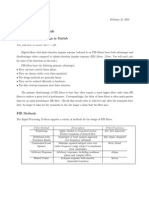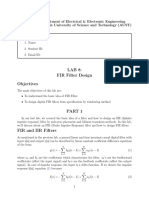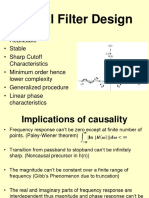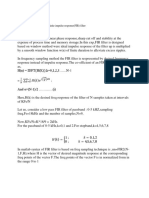0 ratings0% found this document useful (0 votes) 58 views13 pagesFIR Filter Design
Copyright
© © All Rights Reserved
We take content rights seriously. If you suspect this is your content,
claim it here.
Available Formats
Download as PDF or read online on Scribd
UNIT-IV
sat DIGITAL WGK
NY
INTRODUCTION
A filter is a frequency selective system. Digital filters are classified as finite duration unit,
impulse response (FIR) filters or infinite duration unit impulse response (UR) filters,
depending on the form of the unit impulse response of the system. In the FIR system, the
impulse response sequence is of finite duration, ic, it has a finite number of non-zero terms,
The IIR system has an infinite number of non-zero terms, i.e, its impulse response sequence is
of infinite duration. IIR filters are usually implemented using recursive structures (feedback
poles and zeros) and FIR filters are usually implemented using nonerecursive structures (no
feedback-only zeros). The response of the FIR filter depends only on the present and past input
samples, whereas for the IIR filter, the present response is a function of the present and past
values of the excitation as well as past values of the response.
Advantages of FIR filter over IIR filte
FIR filters are always stable
FIR filters with exactly linear phase can easily be designed.
FIR filters can be realized in both recursive and non-recursive structures,
FIR filters are free of limit eycle oscillations, when implemented on a finite word
length digital system,
5, Excellent design methods are available for various kinds of FIR filters
Disadvantages of FIR filters:
1. The implementation of natrow transition band FIR filters is very costly, as it requites
considerably more arithmetic operations and hardware components such as multipliers,
adders and delay elements.
2 Memory requirement and execution time are very high
FIR filters are employed in filtering problems where linear phase characteristics within the
pass band of the filter are required. IF this is not required, either an FIR or an IIR filter may be
employed. An IIR filter has lesser number of side lobes in the stop band than an FIR filter
with the same number of parameters. For this reason if some phase distortion is tolerable,
an IIR filter is preferable. Also, the implementation of an IIR filter involves fewer
parameters, less memory requirements and lower computational complexity:
Characteristics of Fir Filters with Linear Phase
‘The transfer function ofa FIR causal filter is given by
He)=D h(n) 2*
where A(n) is the impulse response of the filter, The frequency response [Fourier transform of
h(n) is given by�Ho
Shyer"
which is periodic in frequency with period 2, i..,
Teo) = Mhot2k ), k=0,1,2.
Since £1(o ) is complex it can be expressed as
Hoy £| Henle
‘where H(o ) is the magnitude response and (a) is the phase response
We define the phase delay + pand group delay +, of a filter as:
For FIR filters with linear phase, we can define
Olo)=-a0 nS 0S x
‘Where a is constant phase delay in samples
a9\0)
ao
ie. "1% ~@ which means that « is independent of
‘requency.
We have
LY hope Hb) @ 7"
LY Honfeose n ~j sian] = + HC) | [e058 (o ) + sin6 (o )]
This gives us
© hia) cose n= +|H (00) | e058 ()
=Y Hn) sino n= |H(w) | sin 0 (o )
‘Therefore, “
Sn6@) _ snow
Shanon OO) exe
¥ Hn fs on cs a cos sin a] =0�© hon sin (a= njo=0
This will be zero when
Win) = MN = 1 9) and
‘This shows that FIR filters will have constant phase and group delays when the impulse
response is symmetrical about a= (I= 1)2.
‘The impulse response satisfying the symmetry condition h(n) = h(N = 1 =n) for odd and even
values of N is shown in Figure 1. When N = 9, the centre of symmetry
of the sequence occurs at the fourth sample and when N = 8, the filter delay ig 3 1samples.
Centre of
©
Figure 1 Impulse response sequence of symmetrical sequences fr (a) N odd (b) N even.
Ifonly constant group delay is required and not the phase delay, we can write
Go) =B - aw
Now, we have
‘my 2 [econo
Sach = ain
5 scene js = + ere) sa
‘This gives�Y hiadeot on = £]M(0) cos weo)
35 nso = |e in)
Drm saan
Sawown
‘Cross multiplying and rearranging, we get
Ff sintetsn sings) snc — i)
F mapsmyp~(a-me
2, the above equation can be written as:
‘This equation will be satisfied when
hn)
‘This shows that FIR filters have constant group delay + z and not constant phase delay when
the impulse response is antisymmetrical about a= (W~ 1)/2
The impulse response sting the antisymmetry condition is shown in Figure 2. When
N= 9, the centre of antisymmetzy occurs at fourth sample and when N= 8, the centre of
antisymmetry occurs at *Zsamples. From Figure 2, we find that h[(W— 1/2] = Ofer
stisymmetric odd sequenee,
Centre of Centre of
@) ©)
Figure 2 Impulse response sequence of antisymmetric sequences fo a) N edd (b) N even�EXAMPLE 1 The length of an FIR filter is 7, If this filter has a linear phase, show that
wet
DY A) sin(e— nyo = 0
“0 is satisfied
‘Solution: The length of the filter is 7. Therefore, for linear phase,
o
E hin sine—mar =F HapsnG—ne
"= A(O) sin 3es + hd) sin 2er + WO) sin 9+ H3) sin 0+ H(A) sin
+ iS) sin (—209)+ 46) sia (30)
°
5 posnce-ma=0
Hence tbe equation 23 is satis
EXAMPLE 2
‘The following transfer function characterizes an FIR filter (N= 9).
Determine the magnitude response and show that the phase and group delays are constant
Sams
Solution: "The wansfer anction ofthe Filter is sven by
“= MOF ADE! +MDz? +H)? + Maz +h) + HOHE
+h)
HS)
‘The phase delay
Hea) = 24 [MO)24 + hiL) 2 + HO) SEM) EADS! ES) A +6
phi 2 hi8)
Since A(n) = AW 1 =n)
IMO)! +1) + AS +) HME + +m]
‘The frequency response is obtained by replacing 2 with ¢�TO) fel Fe LE MYL 4.6
+O FEF] +H
T+ AO)eA* +
olny ea eats]
*hnor]
where [ie i the magaiuude response and 4
delay t, and group delay +, are given by
cece)
do
‘Thus, the phase delay and the group delay are the same and are constants,
Design Techniques for FIR Flilters
‘The well known methods of designing FIR filters areas follows:
1. Fourier series method
2. Window method
3. Frequeney sampling method
‘Optimum filter design
In Fourier series method, the desired frequency response Hz (w ) is converted to a
Fourier series representation by replacing by 2x /T, where T is the sampling time. Then
using this expression, the Fourier coefficients are evaluated by taking inverse Fourier
transform of Ha(o ), which is the desired impulse response of the filter a(n). The Z
transform of ha(n) gives Hale) which is the transfer function of the desired filter. The Ha(2)
obtained from idm) will be a transfer function of unrealizable non causal digital filter of
infinite duration. A finite duration impulse response f(n) can be obtained by truncating the
infinite duration impulse response h(n) to N-samples. Now, take Z-transform of h(n) 10 get
H(2). This H(2) corresponds to a non-causal filter. So multiply this H(z) by 7" to get the
transfer function of realizable causal filter of finite duration,
In window method, we begin with the desired frequency response specification Fdto )
and determine the corresponding unit sample response hd). The h(n) is given by the
inverse Fourier transform of H,(o ). The unit sample response hd) will be an infinite
sequence and must be truncated at some point, say, at n= N'— I to yield an FIR filter of
length NY. The truncation is achieved by multiplying ha(n) by a window sequence w(n). The
resultant sequence will be of length N and can be denoted by h(n). The Z-transform of fin)
will give the filter wransfer function (2). There have been many windows proposed like
Rectangular window, Triangular window, Hanning window, Hamming window, Blackman
wndow and Kaiser window that approximate the desired characteristics
Im frequency sampling method of filter design, we begin with the desired frequency
response specification H.(o), and it is sampled at N-points t0 generate a sequence /1(k)
which corresponds to the DFT coefficients. The N-point IDFT of the sequence H(k) gives
the impulse response of the filter hn). The Z-transform of hn) gives the transfer function
of the filter.
In optimum filter design method, the weighted approximation error between the desired
frequency response and the actual frequeney response is spread evenly across the pass band
and evenly across the stop band ofthe filter. This results in the reduction of maximum error.
‘The resulting filter have ripples in both the pass band and the stop band, This concept of�design is called optimum equiripple design criterion.
The various steps in designing FIR filters are as follows:
1 Choose an ideal(desired) frequency response, Ha( 0).
2 Take inverse Fourier transform of #Z( ) to get hy (n) or sample H(e ) at finite
number of points (N-point) to get A(&).
3. If ha(n) is determined, then convert the infinite duration h(n) to a finite duration
h(n) (usually h(n) is an N-point sequence) or if H(k) is determined, then take
N-point inverse DFT to get f(n.
Take Z-transform of h(t) to get H(z), where A7(=) isthe transfer function of the
digital filter:
5. Choose 2 suitable structure and realize the filter
Design OF FIR Filters using Windows
‘The procedure for designing FIR filter using windows is:
1. Choose the desited frequency response of the filter H(@).
2. Take inverse Fourier transform of Ha ) to obtain the des:
han),
Choose a window sequence (1) and multiply ha(n) by w{n) to convert the infinite
duration impulse response to a finite duration impulse response A(n).
4. The transfer function H(2) of the filter is obtained by taking Z-transform of h(n)
impulse response
3
Rectangular Window
‘The weighting function (window function) for an N-point rectangular window is given by
4 Maden
wet =
oe mine ft Osnsw-y
0. elsewhere
0. elsewhere hewn
The spectrum (frequency response) of rectangular window Wx(0) is given by
the Fourier transform of s(n)�The frequency spectrum for N = 31 is shown in Figure 3. The spectrum Wa(@) has two
features that are important. They are the width of the main lobe and the side lobe amplitude,
The frequeney response is real and its zero occurs when @ = 2k /N where k is an integer.
TThe response for between -2x JN and 2x (NV is called the main lobe and the other lobes are
called side lobes. For rectangular window the width of main lobe is 4x /N. The first side lobe
‘will be 13 dB down the peak of the main lobe and the roll off will be at 20 dBidecade. As the
‘window is made longer, the main lobe becomes narrower and higher, and the side lobes become
‘more concentrated around @= 0, but the amplitude of side lobes is unaffected. So increase in
length does not reduce the amplitude of ripples, but increases the frequency when rectangular
‘window is used,
If we design a low-pass filter using reclangular window, we find that the frequency
response differs from the desired frequency response in many ways. It does not follow quick
transitions in the desired response. The desired response of a low-pass filter changes abruptly
from pass band to stop band, but the actual frequency response changes slowly. This region
of gradual change is called filter's transition region, which is due to the convolution of the
desired response with the window response’s main lobe, The width of the transition region
depends on the width of the main lobe. As the filter length increases, the main lobe
becomes narrower decreasing the width of the transition region
The convolution of the desired response and the window response’s side lobes gives
tise to the ripples in both the pass band and stop band. The amplitude of the ripples is
dictated by the amplitude of the side lobes. This effect, where maximum ripple occurs just
before and just after the transition band, is known as Gibb’s phenomenon,
The Gibbs phenomenon can be reduced by using a less abrupt wuncation of filter
coefficients. This can be achieved by using a window function that tapers smoothly towards
zero at both ends,�W409
J 14440)—Lueal response
[= 1(0)—Approximate response
Figure 3 (a) Rectangular window sequence, (b) Magnitude response of rectangular window,
(c] Magnitude response of Now pas iter approximated using rectangular window.
Triangular or Bartlett Kindow
‘The triangular window has been chosen such that it hs tapered sequences from the middle
con either side. The window function wr(n) is defined as
In magnitude response of triangular window, the side lobe level is smaller than that of
the rectangular window being reduced from -13 dB to -25 dB, However, the main lobe
‘width is now 8 /N or twice that of the rectangular window.
The triangular window produces a smooth magnitude response in both pass band and
stop band, but it has the following disadvantages when compared to magnitude response�obtained by using rectangular window:
1. The transition region is more,
2 The attenuation in stop band is less.
the triangular window is not usually @ good choice
Because of these characteris
Raised Cosine Window
‘The raised cosine window multiplies the central Fourier coefficients by approximately unity
‘and smoothly truncates the Fourier coefficients toward the ends of the filler. The smoother
fends and broader middle section produces less distortion of han) around 1 = 0. It is also
called generalized Hamming window.
The window sequence is of the form:
Hanning Window
The Hanning window function is given by
a +01-ef
wal
clyewhere
The width of main lobe is 8 /N, ie., twice that of rectangular window which results in
doubling of the transition region of the filter. The peak of the first side lobe is -32 dB
relative to the maximum value, This results in smaller ripples in both pass band and stop
band of the low-pass filter designed using Hanning window, The minimum stop band
attenuation of the filler is 44 dB. At higher frequencies the stop band attenuation is even
greater. When compared to triangular window, the main lobe width is same, but the
magnitude of the side lobe is reduced, hence the Hanning window is preferable to triangular
window.
Hamming Window
‘The Hamming window function is given by
0:54 + 0.46 eos| for -|
|
lo —
(
[054 — 0.46 cos
N
lo otic
In the magnitude response for N= 31, the magnitude of the first side lobe is down about 4148
from the main lobe peak, an improvement of 10 dB relative to the Hanning window. But this
improvement is achieved at the expense of the side lobe magnitudes at higher frequencies,
‘which are almost constant with frequency. The width of the main lobe is 8 /N. In the magnitude
response of low-pass filler designed using Hamming window, the fist side lobe peak is ~S1 dB,
which is -7 dB lesser with respect to the Hanning window filter. However, at higher
frequencies, the stop band attenuation is low when compared to that of Hanning window.
Because the Hamming window generates lesser oscillations in the side lobes than the Hanning
‘window for the same main lobe width, the Hamming window is generally preferred.�Blackman Window
The Blackman window function is another type of cosine window and given by the equation
0 otherwise
In the magnitude response, the width of the main lobe is 12x /N, which is highest among
‘windows. The peak of the first side lobe is at~S8 dB and the side lobe magnitude decreases with
frequency. This desirable feature is achieved at the expense of increased main lobe width,
However, the main lobe width can be reduced by inereasing the value of N, The side lobe
attenuation of a low-pass filter using Blackman window is -78 dB.
Table 1 gives the important frequency domain characteristics of some window functions.
‘TABLE 1 Frequency domain characterises of some window functions
Type of “Approximate Minimum stop Peak of first
window ‘transition and attenuation side lobe
width of main lobe (a) «By
Rectangular 4m iN 21 3
Bartlett 8m iN 25 25
Hanning Bn =44 oI
Hamming BxiN 31 41
Blackmann 12 IN 78 58
EXAMPLE 3
Design an ideal low-pass filter with N'= 11 witha frequency response
Solution: For the given desired frequency response,
The filter coefficients are given by�Emenee
nyim=
14) oa
ey a
nyiay= snr =0=n(-4, —ay3)= ain _
nla) = Geant =0= hy uOd= sin
Assuming the window function,
[| foraSenss
va)=
(0, otherwise
1a) = bnd-win) = ha
We have
‘Therefore, the designed filter coefficients are given as
mo) = 4H
Wa) =0=H-4), WS)
‘The above coefficients correspond to a non-causal filter which is not realizable,
‘The realizable digital filer transfer function /7{2) is given by
oan |
10 | K)4 Shien +2
| nO)+ She +241
tel]
HG)
[Osh Le + 4S +21 + W)
FO)? HIDE HHO FAS
= HS) 44G)E7 +
1H
“Sr 3°�‘Therefore, the coefficients ofthe realizable digital filter ae:
Ho}= = HO, A)=0240), HO)
&
his),
18)=0240, W=4
WG), WS)




